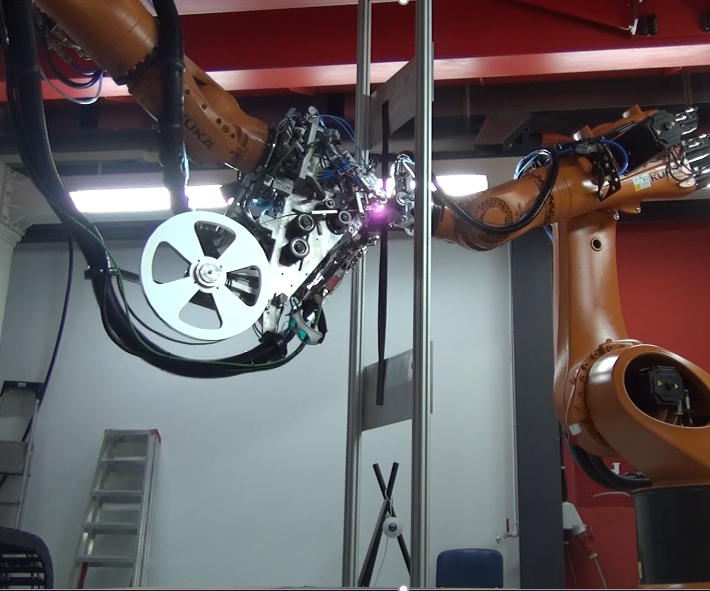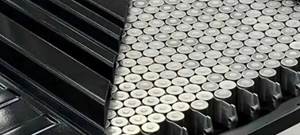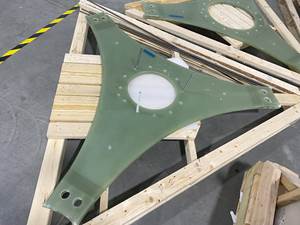General Atomics Aeronautical developing tool-less thermoplastics composites process
Aerospace manufacturer General Atomics Aeronautical Systems Inc. is developing a novel process for the fabrication of thermoplastic composite structures that obviates the need for traditional molds or tooling.

General Atomics' tool-less thermoplastic composites process employs two robots. One (left) applies the carbon fiber/thermoplastic tape. The other (right) provides a movable tooling surface against which the tape is applied.
Aerospace manufacturer General Atomics Aeronautical Systems Inc. (GA-ASI, San Diego, CA, US) is developing a novel process for the fabrication of thermoplastic composite structures that obviates the need for traditional molds or tooling. The system is expected to have application in the aerospace, space, marine and wind energy end markets.
Although it has not been formally named, the tool-less process uses two 6-axis robots working cooperatively to place thermoplastic tape into open space within a metallic or similar frame that provides the boundaries of the structure being fabricated (see photo). Composite Automation LLC (Cape Coral, FL, US), using Mikrosam (Prilep, Macedonia) equipment, worked with GE-ASI to develop the automation.
One robot consists of a standard unidirectional tape placement system that provides laser heating to perform in-situ consolidation of the thermoplastic material. The second “support” robot works directly opposite the automated tape layer (ATL) and consists of a flat metallic surface, providing, in effect, a movable tooling surface against which the ATL places its tape. The tape head and the support head thus move together through 3D space, placing material. Each end of each tape placed is anchored to the frame, which can assume a variety of shapes, depending on the application. Further, the tape can be manipulated by the robotics to change direction within the 3D space to build contoured and complex shapes.
John Geriguis, innovations leader/advanced product development at GA-ASI, has been working with Adam Jones, manufacturing engineering manager, and Paul Sherman, design engineer, on this technology for four years. He says development of the process is ongoing, noting that the company is still working to optimize software systems guiding the robotics. He also says the process is highly dependent on a camera-based in-situ inspection system that detects material and other flaws during the placement process; the system, called real-time virtual assembly tooling (RVAT), developed for GA-ASI by Trilion Quality Systems (King of Prussia, PA, US), is designed to compare the as-manufactured structure with the as-designed CAD data, and then implement tape placement adjustments on the fly to maintain compliance with design specifications.
GA-ASI, says Geriguis, has evaluated several thermoplastic resin systems using the process, including polyetheretherketone (PEEK). However, Geriguis reports that the company has had the most success with Toray’s TenCate Advanced Composites’ (Morgan Hill, CA, US) Cetex TC1225 low-melt polyaryletherketone (PAEK) using a Toray carbon fiber reinforcement.
, but Geriguis says this is being done primarily to protect the company’s use of the technology. In fact, says Geriguis, “we hope that others might want to partner and help develop this technology and mature it.”
Interest in the process so far, outside of General Atomics Aeronautical, has come from NASA, which, says Geriguis, sees the potential for its use to build structures in a space environment. He also believes the process could be deployed effectively to fabricate aircraft fuselage and wing structures, as well as wind turbine blades and naval vessels.
Related Content
Infinite Composites: Type V tanks for space, hydrogen, automotive and more
After a decade of proving its linerless, weight-saving composite tanks with NASA and more than 30 aerospace companies, this CryoSphere pioneer is scaling for growth in commercial space and sustainable transportation on Earth.
Read MoreSRI develops scalable, infiltration-free ceramic matrix composites
Work in two DOE projects is demonstrating C/C-SiC produced in 3-5 days with <5% shrinkage, <10% porosity and 50% the cost of conventional C/C and C/C-SiC.
Read MoreComposites end markets: Batteries and fuel cells (2024)
As the number of battery and fuel cell electric vehicles (EVs) grows, so do the opportunities for composites in battery enclosures and components for fuel cells.
Read MoreRTM, dry braided fabric enable faster, cost-effective manufacture for hydrokinetic turbine components
Switching from prepreg to RTM led to significant time and cost savings for the manufacture of fiberglass struts and complex carbon fiber composite foils that power ORPC’s RivGen systems.
Read MoreRead Next
Next-gen fan blades: Hybrid twin RTM, printed sensors, laser shock disassembly
MORPHO project demonstrates blade with 20% faster RTM cure cycle, uses AI-based monitoring for improved maintenance/life cycle management and proves laser shock disassembly for recycling.
Read MoreCeramic matrix composites: Faster, cheaper, higher temperature
New players proliferate, increasing CMC materials and manufacturing capacity, novel processes and automation to meet demand for higher part volumes and performance.
Read MoreUltrasonic welding for in-space manufacturing of CFRTP
Agile Ultrasonics and NASA trial robotic-compatible carbon fiber-reinforced thermoplastic ultrasonic welding technology for space structures.
Read More












